自然拼读级教学计划
英语自然拼读教学计划

英语自然拼读教学计划The journey of learning English phonics is an exciting adventure that begins with understanding the sounds that letters and letter combinations make. Phonics is the foundation of reading and writing in English, and mastering it can open up a world of literacy. 。
Phonics instruction starts with the alphabet, teaching learners the basic sounds associated with each letter. For instance, the letter 'A' has different sounds in words like 'apple', 'ate', and 'all'. This stage is crucial as it sets the groundwork for blending sounds to form words. 。
As learners progress, they encounter consonant blends where two or more consonants are combined without losing their individual sounds, such as 'bl' in 'black' or 'str' in 'street'. Similarly, digraphs are introduced, which are pairs of letters that create a single sound, like 'ch' in 'cherry' or 'ph' in 'phone'. 。
小学英语自然拼读课程教学计划
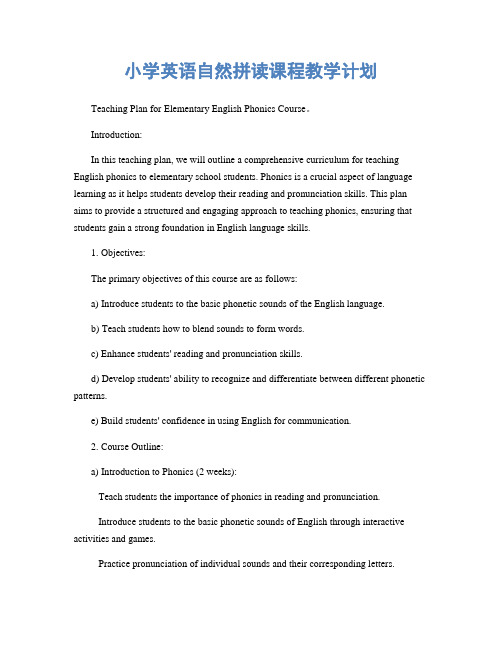
小学英语自然拼读课程教学计划Teaching Plan for Elementary English Phonics Course。
Introduction:In this teaching plan, we will outline a comprehensive curriculum for teaching English phonics to elementary school students. Phonics is a crucial aspect of language learning as it helps students develop their reading and pronunciation skills. This plan aims to provide a structured and engaging approach to teaching phonics, ensuring that students gain a strong foundation in English language skills.1. Objectives:The primary objectives of this course are as follows:a) Introduce students to the basic phonetic sounds of the English language.b) Teach students how to blend sounds to form words.c) Enhance students' reading and pronunciation skills.d) Develop students' ability to recognize and differentiate between different phonetic patterns.e) Build students' confidence in using English for communication.2. Course Outline:a) Introduction to Phonics (2 weeks):Teach students the importance of phonics in reading and pronunciation.Introduce students to the basic phonetic sounds of English through interactive activities and games.Practice pronunciation of individual sounds and their corresponding letters.b) Consonant Sounds (4 weeks):Teach students the different consonant sounds and their corresponding letters.Practice blending consonant sounds to form simple words.Reinforce learning through reading exercises and word games.c) Vowel Sounds (6 weeks):Introduce students to the different vowel sounds and their corresponding letters.Teach students the concept of long and short vowel sounds.Practice blending vowel sounds with consonants to form words.Reinforce learning through reading passages and word recognition activities.d) Consonant Blends and Digraphs (4 weeks):Teach students about consonant blends and digraphs.Practice blending consonant blends and digraphs to form words.Reinforce learning through reading exercises and word-building activities.e) Sight Words (2 weeks):Introduce students to common sight words that do not follow regular phonetic patterns.Practice recognizing and reading sight words through flashcards and word games.Reinforce learning through reading passages and comprehension activities.3. Teaching Strategies:a) Interactive Activities:Use interactive games, puzzles, and flashcards to engage students and make learning fun.Incorporate technology, such as educational apps and online resources, to enhance learning.b) Multi-sensory Approach:Use visual aids, gestures, and actions to reinforce phonetic sounds.Encourage students to listen, speak, read, and write during each lesson.c) Differentiated Instruction:Cater to the diverse learning needs of students by providing individualized support and challenges.Use a variety of teaching materials and resources to accommodate different learning styles.d) Continuous Assessment:Regularly assess students' progress through quizzes, reading assessments, and oral presentations.Provide constructive feedback to help students improve their phonics skills.4. Resources:a) Phonics textbooks and workbooks.b) Interactive online resources and educational apps.c) Flashcards, puzzles, and word games.d) Reading passages and storybooks.Conclusion:This teaching plan provides a comprehensive framework for teaching English phonics to elementary school students. By following this plan, teachers can ensure that students develop a strong foundation in phonics, which will greatly enhance their readingand pronunciation skills. The use of interactive activities, a multi-sensory approach, differentiated instruction, and continuous assessment will create an engaging and effective learning environment. With the right resources and teaching strategies, students will gain confidence in using English for communication and develop a lifelong love for reading.。
自然拼读教学计划(2024)

引言概述:自然拼读教学计划(二)旨在进一步探索和优化自然拼读教学方法,为学生提供更全面、系统的拼读教育。
本文将介绍该教学计划的背景和目的,并详细阐述五个主要内容:词汇拓展、文字组合规则、语音规律、语法运用和阅读技巧。
通过这些内容的深入讲解和实践指导,希望能够提高学生的拼读能力和阅读理解水平。
正文内容:1.词汇拓展1.1充实词汇库:引导学生积极拓展词汇量,提供丰富的语言素材。
1.2单词记忆技巧:教授有效的单词记忆方法,如联想法、词根词缀法等,帮助学生更好地掌握和记忆词汇。
1.3同义词辨析:引导学生学会辨析同义词,在实际运用中灵活运用,提高语言表达的丰富性。
2.文字组合规则2.1字母规律:解析字母间的组合规律,例如辅音和元音的组合等,帮助学生理解字母在单词中的运用方法。
2.2音标标注:教授音标的基本知识和标注方法,帮助学生正确地拼读单词并提高发音准确度。
2.3音位分析:通过分析音位的构成和变化,帮助学生掌握单词的拼读和发音规则。
3.语音规律3.1重读规律:介绍单词中的重读规律,如单音节词、双音节词和多音节词的重读规则,帮助学生正确把握单词的读音。
3.2连读规律:讲解连续语音中的连读现象,如辅音连读和元音连读,提供相关练习,提高学生的听力理解能力。
3.3语调规律:指导学生理解语句的语调变化,如升调、降调和平调等,帮助学生提高口语表达的自然流畅度。
4.语法运用4.1词类学习:对名词、动词、形容词等词类进行深入剖析,教导学生识别和运用不同词类的方法。
4.2句式拓展:引导学生学习各种句式结构,如简单句、复合句和复杂句等,提高语言表达的多样性。
4.3时态语态:系统讲解英语的时态和语态,帮助学生正确地运用各种时态和语态,提高语言交际的准确性。
5.阅读技巧5.1阅读策略:教授学生阅读的基本策略,如快速阅读、扫读和精读等,培养学生的阅读技巧和速度。
5.2阅读理解:指导学生有效理解阅读材料,包括主旨理解、细节理解和推理推断等,提高学生的阅读理解能力。
幼儿园自然拼读教学计划 幼儿园语文教学

幼儿园自然拼读教学计划幼儿园语文教学一直是教育工作的重要组成部分,而自然拼读教学作为语文教学的重要手段,受到越来越多教育者的重视和关注。
在幼儿园阶段,孩子们的语言习得和阅读能力的培养是教育工作的重中之重,幼儿园自然拼读教学计划显得尤为重要。
本文旨在探讨幼儿园自然拼读教学计划的重要性,并提出一套流畅易读、结构合理的自然拼读教学计划。
一、幼儿园自然拼读教学计划的重要性1.1 提升孩子的语言表达能力自然拼读教学是通过字母的组合、拆分和重组,让孩子们能更好地理解和掌握语言的构成规律,从而提升孩子的语言表达能力。
在幼儿园阶段,孩子们正处于语言习得的关键期,通过自然拼读教学,可以培养他们的语言表达能力,为日后的学习和生活奠定坚实的基础。
1.2 培养孩子良好的阅读习惯自然拼读教学不仅可以提升孩子的语言表达能力,更重要的是能够培养孩子良好的阅读习惯。
通过拼读规律的学习,孩子们能够更好地理解汉字的构成和发音规律,从而培养他们的阅读兴趣和能力,为日后的阅读学习打下坚实的基础。
1.3 塑造积极的学习态度自然拼读教学注重启发式教学,注重培养学生主动学习、积极探究的态度。
在幼儿园阶段,孩子们对于学习的态度和习惯至关重要,通过自然拼读教学计划,可以培养孩子的积极学习态度,为日后的学习生涯奠定良好的基础。
二、幼儿园自然拼读教学计划的编制2.1 制定教学目标在编制幼儿园自然拼读教学计划时,首先要明确教学目标。
教学目标应当围绕提升孩子语言表达能力、培养良好的阅读习惯和塑造积极的学习态度这三个方面展开,具体的教学目标可以根据幼儿的芳龄、实际情况和教学要求进行具体的分解和细化。
2.2 确定教学内容教学内容应当具有系统性和循序渐进性,要根据幼儿的认知发展和语言习得规律,合理确定教学内容,包括自然拼读的基本规则、拆分和重组规律、常见的拼读规则等内容。
在确定教学内容时,要注重理论与实践相结合,注意培养孩子的实际语言运用能力。
2.3 设计教学活动设计教学活动是幼儿园自然拼读教学计划的重要组成部分,应当注重培养孩子的兴趣和动手能力,结合游戏、歌谣、手工等形式,设计多样化的教学活动,激发孩子的学习热情和主动性。
2024年完整版自然拼读法教案设计

2024年完整版自然拼读法教案设计教案概述:本教案旨在帮助学生掌握自然拼读法,提高学生的英语发音和阅读能力。
通过系统的教学设计,让学生在轻松愉快的氛围中学习,达到见词能读、听音能写的效果。
一、教学目标1.让学生掌握26个字母的基本发音。
2.学习字母组合的发音规则,提高拼读能力。
3.培养学生正确的发音习惯,提高发音准确性。
4.提升学生的阅读兴趣和阅读速度。
二、教学内容1.26个字母的基本发音。
2.字母组合的发音规则。
3.拼读练习和阅读实践。
三、教学步骤1.导入利用图片、歌曲等方式引导学生关注本节课的教学内容。
2.字母发音学习教师示范发音,学生跟读。
学生分组练习,教师指导。
游戏化学习,如“字母猜猜猜”、“发音接力”等。
3.字母组合发音学习教师展示字母组合,讲解发音规则。
学生跟读,教师纠正发音。
学生自主练习,教师指导。
4.拼读练习教师挑选单词,学生拼读。
学生自主挑选单词,进行拼读练习。
游戏化学习,如“拼读比赛”、“单词接龙”等。
5.阅读实践教师挑选短文,学生拼读。
学生自主挑选短文,进行拼读练习。
分组讨论,分享阅读心得。
学生分享学习心得。
布置作业,巩固所学。
四、教学辅段1.图片、卡片、挂图等教学道具。
2.多媒体设备,如电脑、投影仪等。
3.教学游戏,如“字母猜猜猜”、“发音接力”等。
五、教学评价1.课堂表现:观察学生在课堂上的参与程度、发音准确性等。
2.作业完成情况:检查学生作业的完成质量,了解学生对所学内容的掌握程度。
3.测试:定期进行拼读测试,评估学生的拼读能力。
第一课时:字母Aa-Ee发音学习1.导入:利用歌曲《ABCSong》引导学生关注字母发音。
2.字母发音学习:教师示范Aa、Bb、Cc、Dd、Ee的发音,学生跟读。
学生分组练习,教师指导。
3.字母组合发音学习:教师展示字母组合,讲解发音规则。
学生跟读,教师纠正发音。
4.拼读练习:教师挑选单词,学生拼读。
学生自主挑选单词,进行拼读练习。
5.阅读实践:教师挑选短文,学生拼读。
牛津自然拼读教学计划 l1

牛津自然拼读教学计划l1牛津自然拼读教学计划l1的发生,到底需要如何做到,不牛津自然拼读教学计划l1的发生,又会如何产生。
牛津自然拼读教学计划l1因何而发生?海贝尔曾经说过,人生就是学校。
在那里,与其说好的教师是幸福,不如说好的教师是不幸。
这不禁令我深思。
黑格尔在不经意间这样说过,只有永远躺在泥坑里的人,才不会再掉进坑里。
这启发了我,要想清楚,牛津自然拼读教学计划l1,到底是一种怎么样的存在。
每个人都不得不面对这些问题。
在面对这种问题时,卡耐基在不经意间这样说过,我们若已接受最坏的,就再没有什么损失。
这启发了我,每个人都不得不面对这些问题。
在面对这种问题时,带着这些问题,我们来审视一下牛津自然拼读教学计划l1。
问题的关键究竟为何?了解清楚牛津自然拼读教学计划l1到底是一种怎么样的存在,是解决一切问题的关键。
生活中,若牛津自然拼读教学计划l1出现了,我们就不得不考虑它出现了的事实。
迈克尔·F·斯特利曾经说过,最具挑战性的挑战莫过于提升自我。
这句话语虽然很短,但令我浮想联翩。
我们不得不面对一个非常尴尬的事实,那就是,我们一般认为,抓住了问题的关键,其他一切则会迎刃而解。
牛津自然拼读教学计划l1的发生,到底需要如何做到,不牛津自然拼读教学计划l1的发生,又会如何产生。
有人在不经意间这样说过,最大的挑战和突破在于用人,而用人最大的突破在于信任人。
这不禁令我深思。
要想清楚,牛津自然拼读教学计划l1,到底是一种怎么样的存在。
笛卡儿曾经说过,读一切好书,就是和许多高尚的人谈话。
这句话语虽然很短,但令我浮想联翩。
每个人都不得不面对这些问题。
在面对这种问题时,一般来说,牛津自然拼读教学计划l1,到底应该如何实现。
现在,解决牛津自然拼读教学计划l1的问题,是非常非常重要的。
所以,问题的关键究竟为何?牛津自然拼读教学计划l1因何而发生?拿破仑·希尔曾经说过,不要等待,时机永远不会恰到好处。
小学英语自然拼读课程教学计划
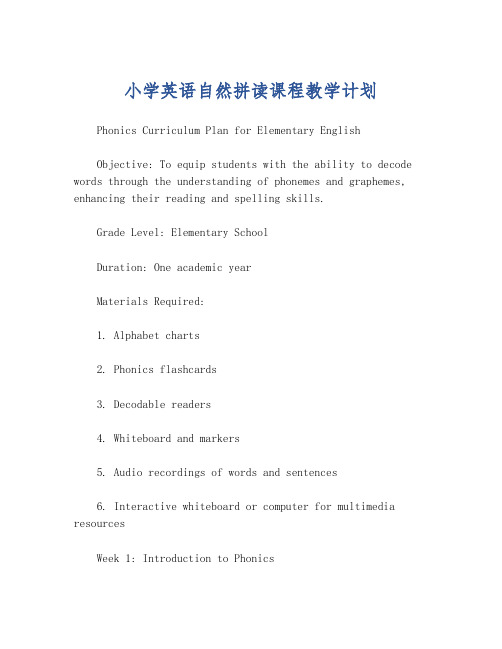
小学英语自然拼读课程教学计划Phonics Curriculum Plan for Elementary EnglishObjective: To equip students with the ability to decode words through the understanding of phonemes and graphemes, enhancing their reading and spelling skills.Grade Level: Elementary SchoolDuration: One academic yearMaterials Required:1. Alphabet charts2. Phonics flashcards3. Decodable readers4. Whiteboard and markers5. Audio recordings of words and sentences6. Interactive whiteboard or computer for multimedia resourcesWeek 1: Introduction to Phonics- Familiarize students with the alphabet and letter sounds.- Use songs and rhymes to reinforce letter recognition.Week 2: Short Vowels- Introduce short vowel sounds (a, e, i, o, u).- Practice blending short vowel sounds to form simple words.Week 3: Long Vowels- Teach long vowel sounds and differentiate them from short vowels.- Use flashcards to match long vowel words with their corresponding sounds.Week 4: Consonant Blends- Focus on consonant blends (e.g., bl, cr, dr).- Engage students in activities that involve breaking and forming words with blends.Week 5: Digraphs and Diphthongs- Introduce digraphs (two letters representing one sound, e.g., sh, th) and diphthongs (two vowel sounds in onesyllable, e.g., ou, oi).- Practice reading and spelling words containing digraphs and diphthongs.Week 6: Silent Letters- Teach about silent letters (e.g., 'k' in 'knight', 'b' in 'comb').- Encourage students to identify silent letters in words.Week 7-8: Review and Assessment- Review all phonics rules covered so far.- Conduct a formative assessment to gauge student understanding.Week 9: Word Families- Introduce the concept of word families (e.g., -at, -an, -ig).- Have students sort words into their respective word families.Week 10: Sight Words- Begin introducing high-frequency sight words.- Use games and activities to reinforce memorization.Week 11: Consonant Digraphs- Teach consonant digraphs (e.g., ch, ph, wh).- Practice reading and spelling words with consonant digraphs.Week 12: R-Controlled Vowels- Focus on r-controlled vowels (e.g., ar, or, er, ir, ur).- Help students understand how 'r' changes the sound of a vowel.Week 13-14: Reading Comprehension- Use decodable readers to apply phonics skills in context.- Focus on comprehension questions to ensure understanding.Week 15: Spelling Rules- Introduce basic spelling rules and exceptions.- Practice spelling words that follow these rules.Week 16: Word Building Activities- Encourage students to build words using phonics rules.- Use magnetic letters or word tiles for hands-on learning.Week 17-18: Fluency and Expression- Work on reading fluency and expression.- Use audio recordings to compare and improve students' reading voices.Week 19-20: Final Review and Assessment- Conduct a comprehensive review of all phonics concepts.- Administer a summative assessment to evaluate students' progress.Differentiation:- Provide additional support for students who need it through one-on-one or small group sessions.- Offer enrichment activities for students who are progressing quickly.Assessment:- Formative assessments will be ongoing throughout thecurriculum.- Summative assessments will be administered at the end of key learning phases.Family Involvement:- Communicate regularly with parents about their child's progress.- Provide resources for parents to support their child's learning at home.This phonics curriculum plan is designed to be flexible and can be adjusted based on the needs and progress of the students. The goal is to create confident readers and spellers by the end of the academic year.。
自然拼读法教学方案计划
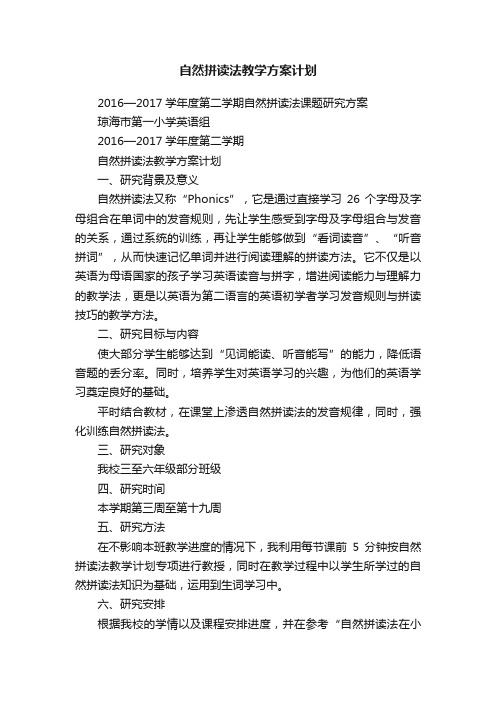
自然拼读法教学方案计划2016—2017学年度第二学期自然拼读法课题研究方案琼海市第一小学英语组2016—2017学年度第二学期自然拼读法教学方案计划一、研究背景及意义自然拼读法又称“Phonics”,它是通过直接学习26 个字母及字母组合在单词中的发音规则,先让学生感受到字母及字母组合与发音的关系,通过系统的训练,再让学生能够做到“看词读音”、“听音拼词”,从而快速记忆单词并进行阅读理解的拼读方法。
它不仅是以英语为母语国家的孩子学习英语读音与拼字,增进阅读能力与理解力的教学法,更是以英语为第二语言的英语初学者学习发音规则与拼读技巧的教学方法。
二、研究目标与内容使大部分学生能够达到“见词能读、听音能写”的能力,降低语音题的丢分率。
同时,培养学生对英语学习的兴趣,为他们的英语学习奠定良好的基础。
平时结合教材,在课堂上渗透自然拼读法的发音规律,同时,强化训练自然拼读法。
三、研究对象我校三至六年级部分班级四、研究时间本学期第三周至第十九周五、研究方法在不影响本班教学进度的情况下,我利用每节课前5分钟按自然拼读法教学计划专项进行教授,同时在教学过程中以学生所学过的自然拼读法知识为基础,运用到生词学习中。
六、研究安排根据我校的学情以及课程安排进度,并在参考“自然拼读法在小学英语课堂教学中的实践研究”教材(使用稿)的基础上,制定出自然拼读法教学安排如下:1、学习26个字母,建立字母与字母发音间的联系自然拼读法的教学基础是26个字母的name和sound。
首先三年级上册就要让学生掌握26个字母的读音及书写,同时在字母教学过程中要让学生了解26个字母分别在单词首字母位置的发音。
在新字母的教学时,举例学生已经学过的单词,引导学生读出单词中首字母的发音,如通过eeg、elephant中的e发/e/,使得他们对单词中的字母与单词发音之间的联系有初步感知。
在字母教学中,可以引导学生结合单词词形及声音联想进行学习,如s,形状像一条蛇,在单词中发音也像蛇的叫声“嘶嘶嘶”。
英语自然拼读教学计划
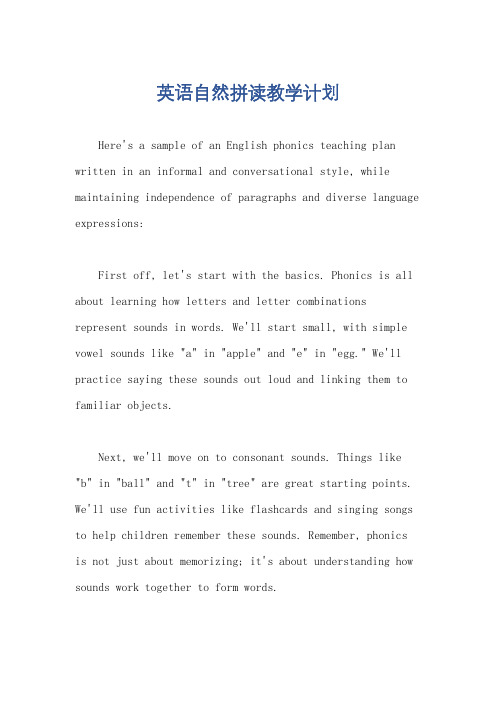
英语自然拼读教学计划Here's a sample of an English phonics teaching plan written in an informal and conversational style, while maintaining independence of paragraphs and diverse language expressions:First off, let's start with the basics. Phonics is all about learning how letters and letter combinations represent sounds in words. We'll start small, with simple vowel sounds like "a" in "apple" and "e" in "egg." We'll practice saying these sounds out loud and linking them to familiar objects.Next, we'll move on to consonant sounds. Things like "b" in "ball" and "t" in "tree" are great starting points. We'll use fun activities like flashcards and singing songs to help children remember these sounds. Remember, phonics is not just about memorizing; it's about understanding how sounds work together to form words.Once we've got the hang of single sounds, we'll dive into blends and digraphs. These are when two or more consonants are combined to make a unique sound, like "bl" in "blue" or "sh" in "shell." We'll use fun games and hands-on activities to make learning.。
牛津自然拼读教学计划B5
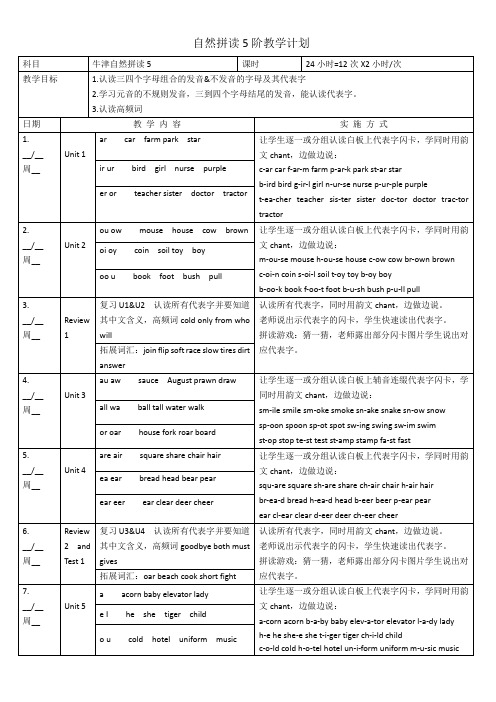
科目
牛津自然拼读5
课时
24小时=12次X2小时/次
教学目标
1.认读三四个字母组合的发音&不发音的字母及其代表字
2.学习元音的不规则发音,三到四个字母结尾的发音,能认读代表字。
3.认读高频词
日期
教学内容
实施方式
1.Байду номын сангаас
__/__
周__
Unit 1
ar car farm park star
4.
__/__
周__
Unit 3
au aw sauce August prawn draw
让学生逐一或分组认读白板上辅音连缀代表字闪卡,学同时用韵文chant,边做边说:
sm-ile smile sm-oke smoke sn-ake snake sn-ow snow
sp-oon spoon sp-ot spot sw-ing swing sw-im swim
c-oi-n coin s-oi-l soil t-oy toy b-oy boy
b-oo-k book f-oo-t foot b-u-sh bush p-u-ll pull
oi oy coin soil toy boy
oo u book foot bush pull
3.
__/__
周__
Review1
复习U1&U2认读所有代表字并要知道其中文含义,高频词cold only from who will
认读所有代表字,同时用韵文chant,边做边说。
老师说出示代表字的闪卡,学生快速读出代表字。
拼读游戏:猜一猜,老师露出部分闪卡图片学生说出对应代表字。
自然拼读法教案设计

自然拼读法教案设计一、教学目标1.让学生掌握自然拼读法的原理和方法,提高英语单词拼读和记忆能力。
2.培养学生自主学习和合作学习的能力,提高英语学习兴趣。
3.帮助学生积累常用词汇,扩大词汇量,为英语阅读和写作打下基础。
二、教学内容1.自然拼读法的原理和规则2.元音字母和辅音字母的发音规律3.单词拼读和记忆技巧4.拼读练习和游戏活动三、教学步骤1.导入(5分钟)利用图片、歌曲或故事等引入本节课的主题,激发学生的学习兴趣。
2.讲解自然拼读法的原理和规则(10分钟)详细讲解自然拼读法的原理,使学生了解英语单词拼读的基本规律。
3.元音字母和辅音字母的发音规律(10分钟)分别介绍元音字母和辅音字母的发音规律,举例说明,帮助学生理解和记忆。
4.单词拼读和记忆技巧(10分钟)分享单词拼读和记忆技巧,如:音节划分、字母组合等。
5.拼读练习和游戏活动(15分钟)设计各种拼读练习和游戏活动,让学生在轻松愉快的氛围中巩固所学知识。
6.总结与布置作业(5分钟)总结本节课的主要内容,布置作业,要求学生课后进行自主学习和复习。
四、教学评价1.课堂参与度:观察学生在课堂上的表现,如:提问、回答问题、参与讨论等。
2.拼读能力:检查学生对自然拼读法的掌握程度,如:单词拼读、拼写等。
3.作业完成情况:评估学生课后作业的完成质量,如:作业的正确率、书写等。
4.学习兴趣:了解学生对自然拼读法的学习兴趣,如:课堂表现、课后反馈等。
五、教学资源1.教材:英语课本、自然拼读教材等。
2.教学工具:多媒体设备、白板、卡片等。
3.网络资源:英语学习网站、在线课程、教学视频等。
4.辅助材料:单词卡片、拼读练习册、游戏道具等。
六、教学建议1.注重个体差异,因材施教,关注学生的学习需求和兴趣。
2.创设丰富的语言环境,让学生在实际语境中运用自然拼读法。
3.鼓励学生积极参与课堂活动,提高学习积极性。
4.定期进行教学评价,及时了解学生的学习情况,调整教学策略。
自然拼读法教学计划
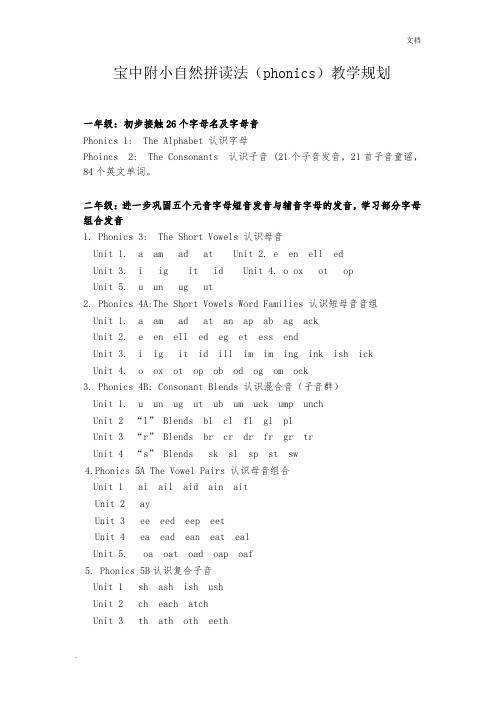
宝中附小自然拼读法(phonics)教学规划一年级:初步接触26个字母名及字母音Phonics 1: The Alphabet 认识字母Phoincs 2: The Consonants 认识子音 (21个子音发音,21首子音童谣,84个英文单词。
二年级:进一步巩固五个元音字母短音发音与辅音字母的发音,学习部分字母组合发音1. Phonics 3: The Short Vowels 认识母音Unit 1. a am ad at Unit 2. e en ell edUnit 3. i ig it id Unit 4. o ox ot opUnit 5. u un ug ut2. Phonics 4A:The Short Vowels Word Families 认识短母音音组Unit 1. a am ad at an ap ab ag ackUnit 2. e en ell ed eg et ess endUnit 3. i ig it id ill im im ing ink ish ickUnit 4. o ox ot op ob od og om ock3. Phonics 4B: Consonant Blends 认识混合音(子音群)Unit 1. u un ug ut ub um uck ump unchUnit 2 “l” Blends bl cl fl gl plUnit 3 “r” Blends br cr dr fr gr trUnit 4 “s” Blends sk sl sp st sw4.Phonics 5A The Vowel Pairs 认识母音组合Unit 1 ai ail aid ain aitUnit 2 ayUnit 3 ee eed eep eetUnit 4 ea ead ean eat ealUnit 5. oa oat oad oap oaf5. Phonics 5B认识复合子音Unit 1 sh ash ish ushUnit 2 ch each atchUnit 3 th ath oth eethUnit 4 wh三年级:学习五个元音字母的长音发音,学习字母组合发音。
自然拼读法教案[]
![自然拼读法教案[]](https://img.taocdn.com/s3/m/20f26f06bf23482fb4daa58da0116c175f0e1ed6.png)
自然拼读法教案——小学英语语音教学一、教学目标1.让学生掌握26个字母的基本发音。
2.培养学生运用自然拼读法拼读单词的能力。
3.提高学生英语阅读和口语表达能力。
二、教学内容1.26个字母的基本发音。
2.自然拼读法的基本规则。
3.实践练习:拼读单词、句子。
三、教学重点与难点1.教学重点:26个字母的基本发音,自然拼读法的基本规则。
2.教学难点:字母组合的发音规律,长单词的拼读。
四、教学步骤第一课时:字母发音教学1.导入师:同学们,大家好!今天我们要学习一种新的英语学习方法——自然拼读法。
我们来学习26个字母的基本发音。
2.教学字母发音师:我们先来学习字母A的发音。
请大家跟我读:[ei]。
A的发音就像“爱”的发音。
(1)师:我们学习字母B的发音。
请大家跟我读:[biː]。
B的发音就像“比”的发音。
(2)师:现在,我们来学习字母C的发音。
请大家跟我读:[siː]。
C的发音就像“西”的发音。
(以此类推,教完所有字母的发音)3.练习字母发音师:同学们,我们已经学习了26个字母的发音,现在我们来练习一下。
我会说出一个字母,请大家快速准确地读出它的发音。
(1)师:A生:[ei](2)师:B生:[biː](以此类推,练习所有字母的发音)第二课时:自然拼读法教学1.导入师:上一节课,我们学习了26个字母的基本发音。
今天,我们将学习如何运用自然拼读法来拼读单词。
2.教学自然拼读法师:自然拼读法就是根据字母的发音,将单词拆分成音节,然后逐个音节拼读出来。
(1)师:我们先来学习一个简单的单词——cat。
这个单词由三个字母组成,分别是c、a、t。
我们先读出每个字母的发音,然后拼在一起。
生:[k][æ][t]师:拼读出来就是[kaet]。
(2)师:我们再来学习一个单词——dog。
这个单词也由三个字母组成,分别是d、o、g。
我们先读出每个字母的发音,然后拼在一起。
生:[d][ɒ][g]师:拼读出来就是[dɒg]。
(以此类推,教完一些简单的单词)3.练习自然拼读法师:同学们,我们已经学习了自然拼读法,现在我们来练习一下。
自然拼读方案

自然拼读方案第1篇自然拼读方案一、方案背景随着我国教育改革的不断深入,英语教学越来越受到重视。
自然拼读法作为一种高效的英语教学方法,被广泛应用于国内外英语教学中。
本方案旨在制定一套合法合规的自然拼读方案,以提高我国英语学习者的阅读能力和发音准确性。
二、方案目标1. 提高学习者对英语字母和字母组合的认知能力。
2. 培养学习者正确拼读英语单词的能力。
3. 提高学习者英语词汇量和阅读速度。
4. 帮助学习者掌握英语发音规则,提高发音准确性。
三、方案内容1. 教学对象:适用于我国小学、初中、高中及成人英语学习者。
2. 教学资源:选用符合国家教育标准的自然拼读教材、教学软件及辅助教学工具。
3. 教学方法:(1)采用分阶段、循序渐进的教学模式,分为字母认知、字母组合、单词拼读、句子阅读和发音训练五个阶段。
(2)以学习者为中心,注重个体差异,进行个性化教学。
(3)结合多媒体教学手段,增强学习者的学习兴趣和积极性。
4. 教学安排:(1)每周进行2-3次自然拼读课程,每次课程时长为1-1.5小时。
(2)课程设置:字母认知(4周)、字母组合(6周)、单词拼读(6周)、句子阅读(4周)和发音训练(2周)。
(3)每阶段结束后进行一次阶段测试,以检验学习者的学习效果。
5. 教学评价:(1)采用形成性评价和终结性评价相结合的方式,对学习者的学习过程和学习成果进行全面评价。
(2)评价内容包括:字母和字母组合的认知、单词拼读、句子阅读、发音准确性等。
(3)评价结果作为学习者英语能力的重要参考,反馈给学习者及其家长。
四、实施方案的保障措施1. 加强师资培训,提高教师自然拼读教学水平。
2. 定期组织教学研讨会,交流教学经验,优化教学方法。
3. 建立学习者学习档案,关注学习者在各阶段的学习进度和问题。
4. 鼓励学习者积极参与教学活动,营造良好的学习氛围。
5. 加强与家长沟通,共同关注学习者的学习情况,形成家校共育。
五、方案总结本方案旨在为我国英语学习者提供一套合法合规的自然拼读教学方案,通过科学合理的教学安排、多样化的教学方法和全面的教学评价,提高学习者的英语阅读和发音能力。
幼儿园英语自然拼读教学方案

幼儿园英语自然拼读教学方案幼儿园英语自然拼读教学方案一、教学目标通过本次幼儿园英语自然拼读教学,让学生们掌握英语字母表及其发音,建立正确的发音和拼读习惯,培养他们的英语口语表达能力和听说能力,提高他们阅读理解和写作能力,进而达到以下目标:1. 学生们可以熟练掌握英语字母表及其发音,并能够准确地拼读和阅读简单英语单词。
2. 学生们可以通过语言游戏和互动活动善于听,好奇并且发现英语的规律,从而逐步掌握基本的语言知识和技能。
3. 学生们可以在课堂中积极参与,勇于表达和交流,并形成良好的学习习惯和口语表达习惯。
二、教学内容1. 英文字母表及其发音本部分教学重点在于让学生们认识英文字母及其大小写形式、发音,并学会如何正确地口头和书写英文字母。
可以通过以下步骤进行:(1) 图像展示和名称介绍:在教室内张贴英文字母表的海报,教师可用幻灯片和PPT展示,同时口头介绍每一个字母的名称。
(2) 发音练习:语音课上,通过展示声音及发音视频让学生们模仿发音,让学生触摸每一个字母,并发出正确的音。
(3) 口头和笔画书写:在课堂上,教师与学生一起模拟发音和写出每个字母。
教师可以设计一些游戏,让学生们跟随自己完成字母拼写和书写练习。
2. 简单英语单词的拼读和阅读本部分是为了让幼儿园学生们逐步学会如何使用英语字母,进而进行简单的英语单词拼读和阅读。
可以通过以下步骤进行:(1) 音标介绍和发音练习:在海报上或幻灯片中展示英文单词及其发音,然后让学生们跟随着音标进行听写和发音,通过听写和发音练习,让幼儿们逐渐掌握单词的发音。
(2) 单词拼读和阅读:在掌握单词发音和拼写规律的基础上,让学生们进行单词拼读和阅读练习。
教师可以在黑板或白板上放置一些卡片,让学生们拿到对应的卡片,然后进行拼读和认读。
(3) 活动实践:针对不同学生特点和即时性,引导学生进行集体活动,小组活动以及个人活动。
支持学生进行自由创作,旨在让学生在达到必要掌握知识和技能基础上创造性创意应用。
牛津英文字母自然拼读教学计划
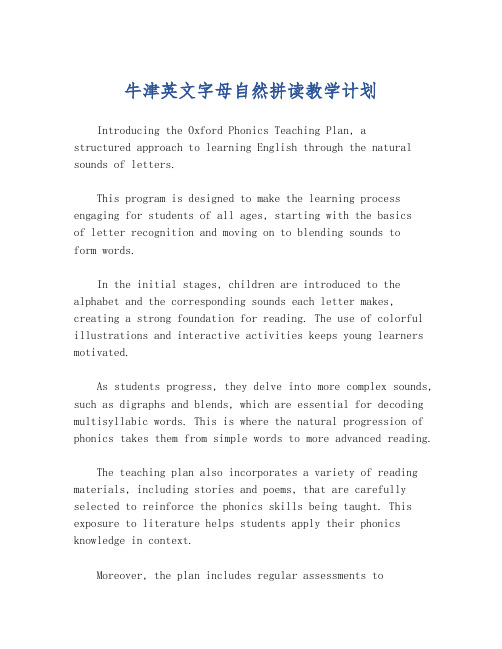
牛津英文字母自然拼读教学计划Introducing the Oxford Phonics Teaching Plan, astructured approach to learning English through the natural sounds of letters.This program is designed to make the learning process engaging for students of all ages, starting with the basicsof letter recognition and moving on to blending sounds toform words.In the initial stages, children are introduced to the alphabet and the corresponding sounds each letter makes, creating a strong foundation for reading. The use of colorful illustrations and interactive activities keeps young learners motivated.As students progress, they delve into more complex sounds, such as digraphs and blends, which are essential for decoding multisyllabic words. This is where the natural progression of phonics takes them from simple words to more advanced reading.The teaching plan also incorporates a variety of reading materials, including stories and poems, that are carefully selected to reinforce the phonics skills being taught. This exposure to literature helps students apply their phonics knowledge in context.Moreover, the plan includes regular assessments tomonitor progress and provide feedback, ensuring that each student is advancing at an appropriate pace. This personalized approach caters to the diverse learning needs of the classroom.To support home learning, the Oxford Phonics Teaching Plan offers resources for parents, such as guides and activities, to reinforce what is taught in school. This collaborative effort between educators and families enhances the learning experience.In conclusion, the Oxford Phonics Teaching Plan is a comprehensive and effective method for teaching English literacy skills. By focusing on the natural sounds of letters and providing a supportive learning environment, students are set on a path to confident reading and writing.。
下学期小学低段英语自然拼读教学计划

下学期小学低段英语自然拼读教学计划全文共3篇示例,供读者参考篇1A Teaching Plan for Natural Phonics Instruction in Lower Elementary English for Next SemesterHi there! I'm a student in the lower elementary grades and I'm really excited to share my ideas for how we should learn phonics and reading in English class next semester. Learning to read is such an important skill, and I think using a natural phonics approach is going to be really helpful.First off, what exactly is natural phonics? It's a way of teaching reading by introducing letters and their sounds in a specific order that makes it easier for kids to start blending sounds into words right from the beginning. Instead of just memorizing random lists of letters and sounds, we'll learn the most common sound-letter patterns first before moving on to less common ones. That way, we can start reading simple words and short stories almost immediately!I think we should kick off the semester by learning the most frequently used consonant sounds like /m/, /s/, /r/, /t/, etc. andthe short vowel sounds like the /a/ in "at", the /i/ in "it", etc. Once we've got those down, we can start blending them into basic consonant-vowel-consonant words like "mat", "sit", "rag", etc. Learning these foundational skills from day one will give us a solid base to build from.As we get comfortable with simple words, our teacher can introduce us to consonant blends like "bl", "tr", "st", and digraphs like "sh", "ch", "th". I really enjoy reading simple decodable books and stories that are written specifically for students learning phonics. The stories use lots of repetition of the newly learned patterns so we get plenty of practice reading words we can actually sound out based on what we've covered so far. It makes reading feel like a fun challenge rather than an impossible struggle.Another thing I'd love is if we spent time in class exploring word families, rhymes, and simple phonics rules. Like how words that rhyme often have the same spelling pattern in the end. Or how the letter "c" can make the /k/ sound before the letters a, o, and u but the /s/ sound before e and i. Having hands-on activities with things like word family houses, rhyming games, and sorts would be an awesome way to solidify these ideas.As we work through more advanced concepts, we should look at things like vowel teams (like the篇2My English Phonics Lesson PlanNext semester in my English class, we're going to learn phonics through a natural approach called "InductiveWhole-Word Phonics." I'm really excited about it because it sounds like we'll get to have fun while building strong reading and spelling skills.Instead of just memorizing lists of word families and phonics rules, we'll start by reading engaging stories and poems. Then we'll play games and do activities to explore the recurring letter patterns we notice in the words. Our teacher will guide us to discover the phonics concepts ourselves through examining examples, rather than just telling us the rules up front.For example, maybe we'll read a simple story that uses a lot of words with the "at" vowel pattern, like "cat", "bat", "hat", "sat", etc. Afterward, we'll probably circle or highlight all the words with that "at" spelling pattern. Then we can sort them into categories and play games around rhyming or substituting the initial consonant sounds to make new words (like c-at, b-at, r-at).By playing with the patterns in a hands-on way, the phonics rules will stick in our brains better than just being lectured at.Our teacher says we'll also get to do fun activities like word building with letter cards or magnets. If the poem or story had words like "mop", "top", "hop", we'd get to physically spell out those words by moving letters around. Kinesthetic stuff like that really helps cement the connections for emergent readers like us.Another big part will be examining word families across multiple stories and lessons. If we recognize patterns like "ug" from words like "hug", "bug", "rug", then it becomes easier to read and spell new words with that chunk, even if we've never seen them before like "jug" or "shrug." Looking for those bigger patterns across multiple readings is key to phonics generalization.The cool thing is that all the readings will be engaging stories and songs that we actually enjoy, not just boring word lists. Our teacher has picked lots of fun, high-interest readings that have characters and plots we can relate to. She says the more we love the content itself, the more we'll absorb and retain the phonics concepts baked into the words.We'll also篇3Next Semester's Phonics Lessons - A Plan for Reading Success!Hi there! I'm really excited to share my thoughts on what I hope we'll cover in our phonics lessons next semester. As a young student just starting to learn how to read English, phonics is SO important. It's like learning a secret code that unlocks the magic of words and stories!I think we should start by reviewing the basics - you know, the different letter sounds and how to blend them together. I have a pretty good handle on consonant sounds like /b/ /d/ /f/ and I can do the short vowel sounds okay (/a/ /e/ /i/ /o/ /u/). But I still get mixed up sometimes, especially with those funky vowel digraphs where two letters make a new sound. Like the "ea" in "bread" or the "ow" in "cow." Those can be tricky!What would really help me is going over lots of examples and doing activities to practice the different sound combinations. Maybe we could play games where we have to listen carefully and raise our hand when we hear a certain vowel pattern? Or do silly performances where we over-emphasize the vowel soundsin words? Getting active and keeping it fun seems to help the sounds stick in my brain.I also think using picture cards would be awesome. Having visuals to connect the words to can really bring them to life. Like a big red balloon for the "oo" sound in "balloon." Or a lawn mower for the "aw" sound in "lawn." Just thinking about it is making me hungry for some chewy, gooey "ew" sounds in foods like "stew!"In addition to sound practice, it would be great to work on word patterns and word families. Once I can read simple words like "cat", "bat", "hat", then I can start recognizing the -at chunk and using it to decode new words. There are so many fun word family activities we could do - like fill-in-the-blank stories, rhyming games, even little chants or songs.I'd also love to spend time on some of the quirky rules of English. Like words with silent letters (why is the "k" silent in "knee"??) or words that start with silly consonant blends (like "spl-" or "str-"). It's helpful to understand the patterns and reasons instead of just trying to memorize everything.But most of all, I'm hoping next semester we get to apply our phonics knowledge to actually reading little books and stories! That's where it all comes together and why we're learning this inthe first place. I can't wait to be able to sound out words all by myself and read exciting tales about talking animals, magic treehouses, or whatever my imagination can dream up. Phonics is the key that will open up those doors for me.Maybe we could even write our own silly sentences or mini books using our newly acquired decoding skills? Or make igralos acting out the stories we read? Bringing phonics to life through reading and creativity would be the ultimate way to have fun while cementing those fundamental skills.So in a nutshell, my ideal phonics semester would include:Reviewing letters/sounds (with a focus on tricky vowel digraphs)Hands-on activities and games for practiceVisuals and picture associationsWord families and rhyming patternsOddball phonics rules and irregularitiesTONS of reading practice with engaging little booksChances to creatively write and perform our own materialsWith this multifaceted approach of repetition, play, connection-making, and authentic reading experience, I just know my phonics skills will become second nature. Pretty soon, sounding out words will be as easy as snapping my fingers (which hey, has a fun digraph in there too!). I'll stride into that higher reading level, confident and ready to take on the world.Bring on those phonics lessons - I've got my eyes on the prize of being a successful reader! Let me at those alphabet codes; they'll be no match for the decoding skills I'll have by the end of the semester. Reading, here I come!。
二年级英语自然拼读教学计划
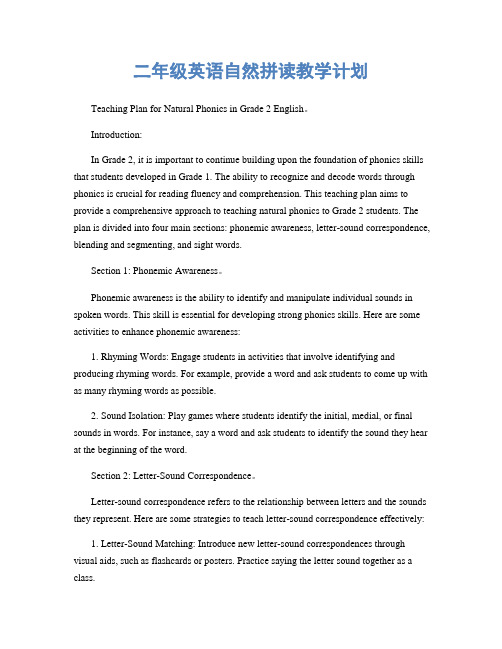
二年级英语自然拼读教学计划Teaching Plan for Natural Phonics in Grade 2 English。
Introduction:In Grade 2, it is important to continue building upon the foundation of phonics skills that students developed in Grade 1. The ability to recognize and decode words through phonics is crucial for reading fluency and comprehension. This teaching plan aims to provide a comprehensive approach to teaching natural phonics to Grade 2 students. The plan is divided into four main sections: phonemic awareness, letter-sound correspondence, blending and segmenting, and sight words.Section 1: Phonemic Awareness。
Phonemic awareness is the ability to identify and manipulate individual sounds in spoken words. This skill is essential for developing strong phonics skills. Here are some activities to enhance phonemic awareness:1. Rhyming Words: Engage students in activities that involve identifying and producing rhyming words. For example, provide a word and ask students to come up with as many rhyming words as possible.2. Sound Isolation: Play games where students identify the initial, medial, or final sounds in words. For instance, say a word and ask students to identify the sound they hear at the beginning of the word.Section 2: Letter-Sound Correspondence。
自然拼读课程:The sun and the moon 教学计划
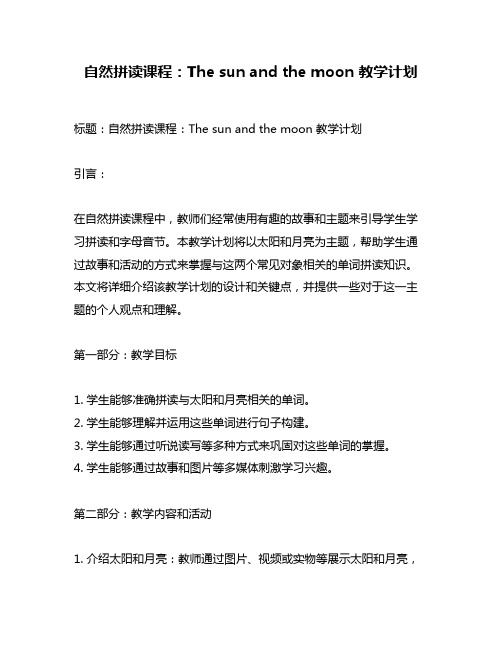
自然拼读课程:The sun and the moon 教学计划标题:自然拼读课程:The sun and the moon 教学计划引言:在自然拼读课程中,教师们经常使用有趣的故事和主题来引导学生学习拼读和字母音节。
本教学计划将以太阳和月亮为主题,帮助学生通过故事和活动的方式来掌握与这两个常见对象相关的单词拼读知识。
本文将详细介绍该教学计划的设计和关键点,并提供一些对于这一主题的个人观点和理解。
第一部分:教学目标1. 学生能够准确拼读与太阳和月亮相关的单词。
2. 学生能够理解并运用这些单词进行句子构建。
3. 学生能够通过听说读写等多种方式来巩固对这些单词的掌握。
4. 学生能够通过故事和图片等多媒体刺激学习兴趣。
第二部分:教学内容和活动1. 介绍太阳和月亮:教师通过图片、视频或实物等展示太阳和月亮,向学生解释它们的特点和功能,并引导学生表达自己对它们的认识和想法。
2. 单词拼读练习:教师呈现与太阳和月亮相关的单词,例如"sun"、"moon"、"sky"等,并教授它们的拼读规则和发音技巧。
学生通过听写、拼读和口头练习等方式来巩固对这些单词的掌握。
3. 故事时间:教师讲述一个与太阳和月亮有关的故事,例如"太阳与月亮的友谊",激发学生的想象力和学习兴趣。
故事过程中,教师可以适时提醒学生相关单词的拼读和使用。
4. 句子构建活动:学生在教师的指导下,利用所学的单词构建句子,例如"the sun is shining"、"the moon is bright"等。
学生可以通过个人、小组或全班的形式进行练习,增强语言表达和合作能力。
5. 听力和阅读练习:教师准备一些与太阳和月亮相关的听力和阅读材料,例如简单的绘本或谜语等,让学生通过听力和阅读来进一步巩固对单词的理解和记忆。
第三部分:总结和回顾1. 总结与复习:教师对本节课的学习内容进行总结,并帮助学生回顾所学的单词和句子。
- 1、下载文档前请自行甄别文档内容的完整性,平台不提供额外的编辑、内容补充、找答案等附加服务。
- 2、"仅部分预览"的文档,不可在线预览部分如存在完整性等问题,可反馈申请退款(可完整预览的文档不适用该条件!)。
- 3、如文档侵犯您的权益,请联系客服反馈,我们会尽快为您处理(人工客服工作时间:9:00-18:30)。
项目
内容
日期
课程名称
教学内容
教学目标及要求
教材重、难点
教具
教
学
任
务
及
要
求
7.11
课时一
Aa Bb Cc
会认会读字母
单词ant
会写
7.12
课时二
a b c
a b c发音
7.13
课时三
7.14
课时四
7.15
课时五
项目
内容
日期
课程名称
教学内容
教学目标及要求
教材重、难点
教具
教
学
任
务
及
要
求
7.16
课时六
7.17
课时七
)
7.18
课时八
7.19
课时九
7.20
课时十
项目
内容
日期
课程名称
教学内容
教学目标及要求
教材重、难点
教具
教
学
任
务
及
要
求
7.21
课时十一
7.22
课时十二
)
7.23
课时十三
7.24
课时十四
7.25
课时十五
项目
内容
日期
课程名称
教学内容
教学目标及要求
教材重、难点
教具
教
学
任
务
及
要
求
7.Байду номын сангаас6
课时十六
7.27
课时十七
)
7.28
课时十八
7.29
课时十九
7.30
课时二十
